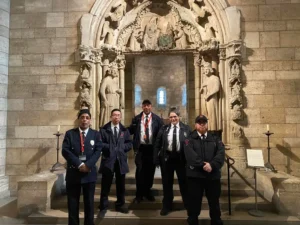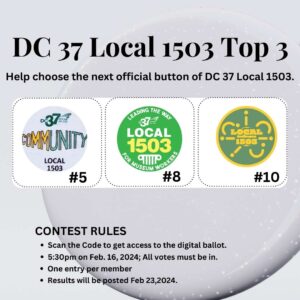Art of the Guardians
On Tuesday, October 18, 2022, some of our AFSCME DC37 Local 1503 siblings participated in a panel discussion; Art of the Guardians: Curator discussion and Employee Panel. The purpose of this panel was to explore how creativity and a love for the art they protect enabled museum security personnel to respond to, endure, and recover from the most acute challenges presented by the Covid-19 pandemic. A panel of officers discussed how they maintained their resiliency throughout the pandemic, how their organization supported them, and the effect that staff art exhibits have had on their job satisfaction and overall well-being. This discussion was a part of the Smithsonian’s National Conference on Cultural Property Protection. The theme for the 2022 conference was Risk Management to Cultural Property in the New Normal: Resilience, Retention, and Recovery.
The Smithsonian is the founder and driver of the National Conference on Cultural Property Protection. A volunteer board of directors provides oversight and ideas for the Conference. The director of the Smithsonian Institution’s Office of Protection Services serves as chair. The Met’s very own Chief Security Officer, Regina Lombardo, served on the advisory board.
This panel included four of our AFSCME DC37 Local 1503 siblings Senior Security Officer Louisa Lam, Senior Security Officer Emilie Lemakis, Senior Security Officer Maureen Catbagan, and Senior Security Officer Jevijoe Vitug. In addition, on the panel was Lambert Fernando, Senior Security Manager at the Met.
Senior Security Officer Louisa Lam, Senior Security Officer Emilie Lemakis, and Senior Security Officer Maureen Catbagan share their experiences below.
(Thank you for sharing)
Louisa Lam’s transcript
There are few roles in New York so known and unknown as a Met Guard. In the same five minutes, we can be asked to expound on German Expressionism, and have eating mimed to us in an effort to find the cafeteria. Within our ranks, a long tradition of gig workers—musicians, working artists, writers, actors—people who know how to maximize long stretches of quiet, who seek to be immersed in the acres of human achievement and inspiration.
Within our ranks, single parents, retired professors, burnt-out healthcare workers, Fulbright scholars. Within our ranks, wary comedians, first-generation immigrants, last-jobs-before-pension.
Within our ranks, fresh graduates and octogenarians, multilingual doctors, war veterans, strained breadwinners, migrant souls and lifers.
Within our ranks, disaffection, bitterness, tenderness, loyalty, and the particular strain of courage that everyone is in the habit of receiving, though few are prepared to recognize and reward.
We hail from Egypt, Albania, Columbia, Bangladesh, Ecuador, Cuba, England, Iran, Iraq, Guyana, Algeria, Argentina, Puerto Rico, the Dominican Republic, Haiti, the Philippines, the Ivory Coast, Burkina Faso, Staten Island, Jersey, Coney Island, Flatbush, Honolulu. As the collection is encyclopedic, so too are the origins of guardianship.
In March 2020, after weeks of mounting uncertainty, the Met decided to close its doors to the public, sending most of its staff on lockdown.
In August of 2020, it was decided by the powers that be that the Met should reopen to the public, to help provide a sense of continuity and sanctuary for a city sorely in need of both.
This was well before vaccines, and just after the protests for George Floyd. This was when we were still counting the dead, and the trains rattled through almost empty, ferrying only the desperate and those deemed essential. Met guards, dispatchers, engineers and maintainers are among those with that double-edged title.
I, as a senior security guard, stayed home for 5 months. But are those of us who served the entire way through. Supervisors, special officers, early watch and late watch never retreated into lockdown, because the Met can never be entirely unmanned. For months, they walked dark and silent corridors, galleries, offices and catwalks with flashlights, checking for leaks, locks, fluctuating temperatures, and advancing pests, emboldened by the lack of traffic. Some of them stayed in cavernously quiet hotels, afraid of what they might bring back to multigenerational homes.
But we came back. We were scared, and appropriately spaced, but glad to see each other. The world was skewed, faces and confidence were halved, social skills were understandably frayed and raw. When the doors reopened, the first visitors threw up their arms and fell to their knees.
New challenges availed themselves immediately. Tantrums over masks, new check-in procedures, lessened services and lessened patience, all of which had to be addressed by those in service.
Humans can be magnificent under duress. During lockdown, the network of social bonds cultivated before lockdown helped guards support each other, disseminating information and resources. And because we were thrust back into the public sphere significantly sooner than your average New Yorker, we became adept at anticipating the needs, anxieties and stresses that steered the behaviors of the visitors and staff. Being able to communicate calm and safety was a challenge that we met with good grace.
People found themselves in need of poetry, and poets found themselves in need of community. Zoom readings replaced open mics, YouTube and TikTok the new bars and cafes. Like art, people are always in need of poetry, and might not be able to articulate that need. But it’s there. As we are here. Lending rhythm, brevity, and the space to grieve, revel and grow.
While this world has changed us, we may, in turn, change the world with our service, with our steadfastness, with our creation, wholeness and love.
———————————
This poem is the first sputter,
post gut-punch. This poem is a ball
bouncing into traffic. This poem
is heavy-headed and husky as peonies,
immodest rouged mouthful.
This poem has a tongue pointed
as flame, as arrow-headed tulip.
This poem waited as quietly as it could
for spring, for amethyst reprieve.
This poem ugly-cried for the bees
that wandered hungry into winter.
This poem goes on tiptoe,
fanning its crest and wingtips,
to reaffirm the bond, even as you are—
empty-handed, lost, nothing
but the dew on your skin
and a single match
tucked behind your ear.
You can rail and run, rebuff,
ball this poem into a fist,
but it never stops dancing,
scrolling open like a chain
of paper dolls or mirrors in mirrors.
But this is not a hunt, or a war.
The poem will dismount.
It will remove its crest and helm,
all the green and gold feathers
shimmy to the ground
like tasseled pollen, spent cherry.
This poem leaves barefoot
in eddies of petals and dust,
sun-bleached hips full of sky,
rounded and curved as adobe.
Emilie Lemakis
On August 2018 I posted on Instagram
“I’m enamored of all the quilts in #historyrefusedtodie exhibition but this one by Mary Elizabeth Kennedy, Log Cabin Quilt, ca. 1935 keeps me. Kennedy blasts through the log cabin pattern with improvised wildness leaving us without a center. I can’t settle down when I look at it and I’m learning all about a way of life I’ve never lived. Kennedy seems to say, “We’re not done here, so get up and let me lead you around “my way” I’ve got so much to say all dressed up in my blue and white fabric.”
I had no experience with a sewing machine or quilting, but I had the material. This piece was sewn completely from used and discarded Metropolitan Museum security guard uniforms that my female co-workers once wore and that I had been collecting for years. The light blue uniform I’m wearing security wore till 2002 when they changed to the darker blue ones. The 27 white stars placed throughout the piece were cut from our white dress shirts to represent the number of years I had worked as a guard at the Met. The hands, face, and shoes were drawn on and cut from the uniform’s pant pockets and the lines of text at the top of the piece were sewn onto the insides of the pants’ waistbands. The left hand in the piece was inspired by a sculpture of the Buddha in the Met’s collection titled “Buddha Offering Protection”, with eyes I added to the fingertips to personalize its watchfulness to everyone who visits this wall hanging. In the right hand I hold a paper airplane made from fabric I had printed from our yellow “late notice” slips guards receive whenever they are late to work. Which I confess getting to work on time has been a struggle for me over the years! My record is getting better.
I made this piece out of the love and gratitude I feel towards the museum and my co-workers. I’ve spent most of my waking life in the last 28 years, at my job, and have learned so much from the people I work with–who I really regard as a second family. Working a job with a very diverse body of workers is one of the great benefits of my job, along with the free art education.
The text in my piece was inspired by the pottery and poems of Dave Drake an enslaved African American who lived in Edgefeild, south Carolina who frequently adorned his large ceramic vessels with short poems and couplets below the rim.
On May 25 2021 I posted on my Instagram:
“I wanted to share this incredible storage jar made by the potter and poet David Drake on this day, the first anniversary of George Floyd’s death. I feel a range of emotions when I look back over this year but it was really the visceral reaction to the horror of that 8:46 video that went viral which began another chapter In our pandemic existence. In the months before Memorial Day we were all trying to stay apart; then after the video traveled at warp speed we came out of our shelters to protest together. When George Floyd stopped breathing we became his breath. The protest exploded into action. Because so few of us were working onsite our daily work became going to a rally. And when they emptied the prisons because of a contagious virus they filled them up with protesters. It became about so much more, about so many other Black and Brown people senselessly murdered. Our long-ago history with slavery keeps mutating, getting better on some fronts, more insidious in other ways. I remain hopeful and find art, music, writing, and our country’s renewed social and political activism inspirational, which brings me back to one of my favorite objects: this large vessel in the American Wing of the Metropolitan Museum of Art. I see a Black man’s personal protest from another time. David Drake was born into slavery around 1801 on a North Carolina plantation. How he learned to read and write seems to have no definitive answer, but we do know it was illegal for an enslaved person to be literate. Under the most dehumanizing conditions Drake was prolific and a master of his craft. His work is about ownership, as his name and creative expressions are effortlessly drawn on the ceramic’s still-wet surface that dry into permanence. The object’s powerful earthly beauty feels like a self-portrait of a free man. His story and George Floyd’s I carry inside me. “
The last line, “everybody is a star”, is basically saying that any one person and job within my workplace is not any more important than any other. If you have an office with a view or you change in a locker room on the ground floor, the collection and public depends on everyone equally for their visiting experience. The daily operations of the museum, which are vast, is a coordinated effort and collaboration required by and involving everyone.
My experience during the lockdown was that I had a lot of time to think and not work–and therefore to think about work. The pandemic left a lot of us in a suspended reality, not really knowing when we would resume our previous lives. I knew the job I left on March 11 would be very different from my first day back to work on August 3rd. So much had happened in those months of lockdown, and I think it will take years to understand the impact on our lives and the world. I personally felt humbled by the experience and wanted to create an artwork emphasizing and reinforcing inclusivity and healing from the past several years.
Maureen Catbagan’s transcript
Would you tell us what it was like to work in empty halls and buildings that once teemed with visitors?
I was not designated as essential Security personnel that was required to be present in the building during shutdown. I thought a lot about the safety of my colleagues who showed up at work under a climate of unknown conditions and health uncertainties as well as having to contend with the difficulties of limited commute service.
What was it like to deal with the day-to-day uncertainty and the need to pivot as new challenges arose?
Multiple changes in procedures and protocols regarding work and safety was stressful but I understood that this was an unprecedented circumstance that we were dealing with so my colleagues and I stepped up and did what needed to be done.
The current changing conditions taught me to be more flexible with changes regarding constantly shifting conditions. It also taught me to care more for the well being of my colleagues as we have all gone through a lot during these past couple of years. As a result, my current art practice addresses themes of the value of labor, forming communities, systems of care, and interdependencies. as well as modes of healing.
How did your organization provide support for you during the pandemic?
The Museum financially supported and continued to pay non-essential staff and Security even when they weren’t present in the building during shutdown. The Met provided masks and gloves as well as social distancing protocols. Also, surprisingly, some Met Museum staff outside of Security organized and created a Mutual Aid system and approached me to find ways to connect to Security staff who might need some financial support.
What I’ve learned to value during this difficult time is the complex humanity of my colleagues that deserve respect and admiration beyond being a body in a uniform. We’ve learned to look out for each other more and care at a deeper level. We have learned that each of us have rich lives and artistic visions that is in itself an untapped living cultural asset within museums. And that our perspectives can be another valuable educational component that would further inspire visitors.





